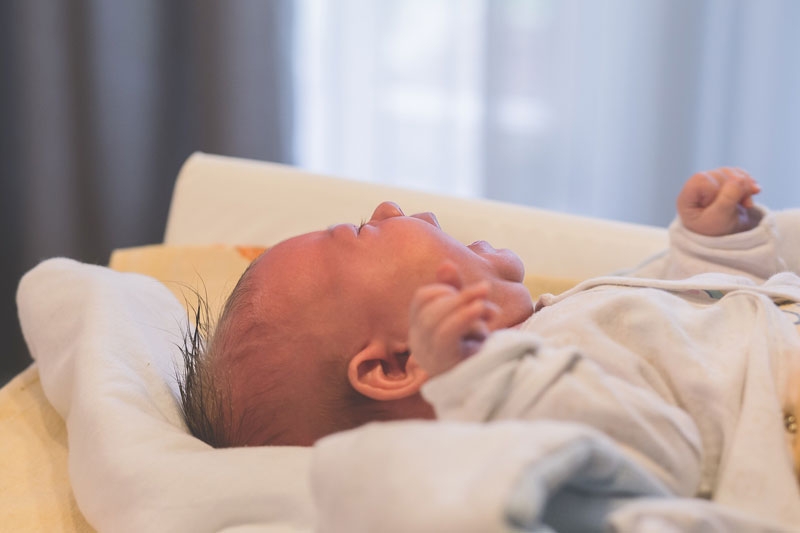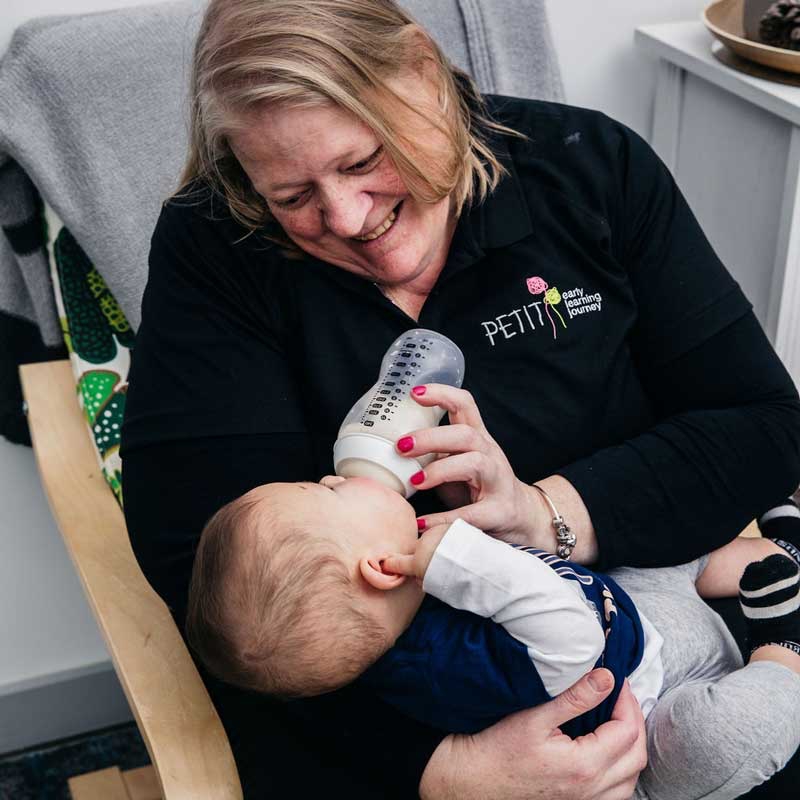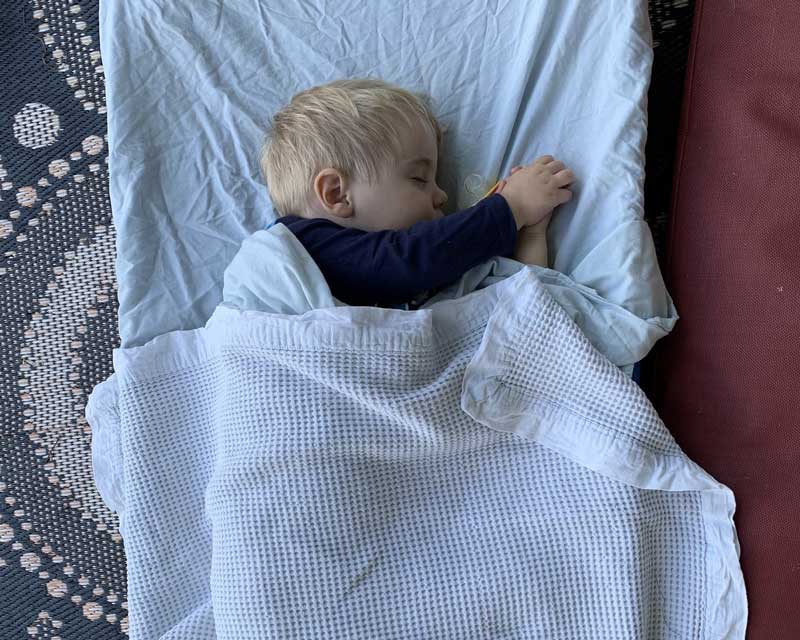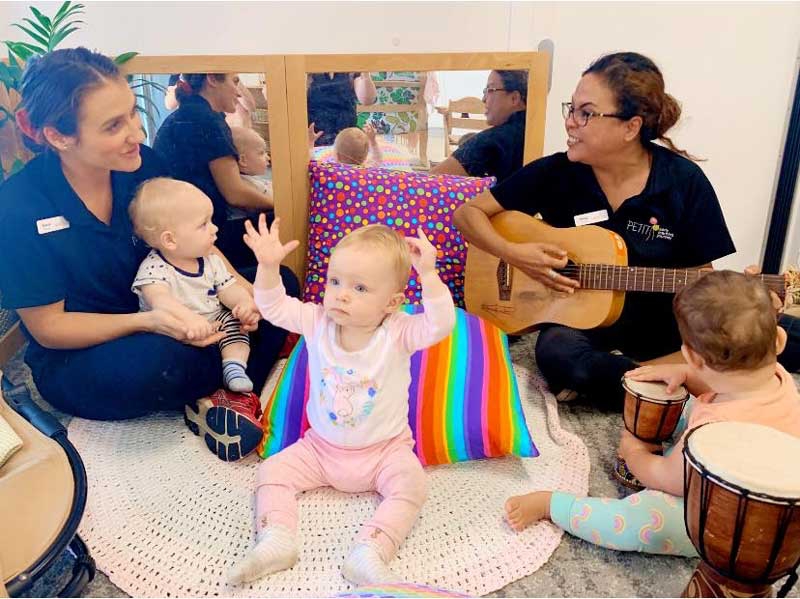Baby Cry Soundboard Baby Cry Soundboard Add to Discord
Babies make lots of dissimilar noises, from giggles to grunts to babe babble. Well-nigh of the time, they're happily engrossed in their new globe. However, when a need arises, they take to let you know, and crying always gets your attention. Knowing baby crying sounds ways you can soothe them more quickly.
New families can observe information technology challenging to understand what each crying sound means. You'll be relieved to know that babies really take their own language and, interestingly, it'due south the aforementioned no matter where your infant was born. It's a universal baby language and the good news is that yous can easily learn it.
The team at Petit Early Learning Journey has plenty of practice studying what each different audio signifies. And, we'd love to share our experience with you then that you tin can sympathize the different cries of your baby and their needs. Our research covers:
- Why babies cry.
- Our top eight baby crying sounds.
- Common types of cries.
- A brusk review of the Dunstan Baby Language especially newborn crying.
- How to calm a baby.

Why practice babies cry?
The first few weeks subsequently the birth of a new baby can be stressful for families as they effigy out why their newborn babies are crying. Baby crying sounds express different needs or emotions. While yous might exist a natural at cracking the code on some types of crying, most new parents do good from a bit of support.
Parents of babies need to await afterward themselves during the start few weeks. When healthy and calm, you have more energy to nurture a meaningful relationship with your little one and present a positive role model for your baby to acquire from while responding to their different types of cries.
Here are some "crib" notes to assist inkling you into what your infant may be maxim (or screaming):

The top 8 reasons why your baby is crying
1. Your baby has a dirty nappy
Babies cry a lot in their first few months. There are many types of baby cries, but your baby will let you know when they have a moisture or full nappy. A moisture or dirty nappy is one of the top reasons babies are uncomfortable. No 1 wants to wear a total nappy for longer than they have to.
Listen for: A whiny, nasal, persistent weep with a curt cry sound followed by a longer i. As the sounds turn into intense crying, it is a signal that the baby has had enough. Check to see if they have a total or dirty nappy.
two. Your infant is hungry
This type of cry relates to breastfed babies and canteen-fed babies. It tin take a slow introductory stage where a baby is waking and realising they're hungry. At get-go, it might sound like fussy crying, but after a while, the cries become more frantic to a betoken where they are louder, longer and more enervating.
Listen for: A blazon of weep that sounds like a siren. The sound is oftentimes accompanied past putting the hand to the oral fissure, clenching fingers and turning their head towards the bottle or breast.
3. You have a tired baby
Babies cry to communicate with their parents. For case, they may cry because they're hungry, uncomfortable or tired. Cindy Davenport from Safe Sleep Space, a Petit ELJ partner and sector skilful, advises families to "look, listen and call up about what might exist going on". And then, respond to a infant'south cues.
During the beginning few weeks, newborn babies rely primarily on their cry and reflexes to communicate. Then y'all might notice them yawning, endmost their eyes, making jerky movements, putting their fist to their oral fissure and sucking on their thumb. An older baby may rub their eyes equally they develop.
Mind for: High pitched crying baby sounds that have a lot of jiff behind them. They oftentimes brainstorm as curt soft whimpers that increment in intensity until the child's needs are met. This is a cry that your natural senses will tune into and larn.

four. You have a sick baby
This cry can be tough for parents of babies and carers to hear, just it usually signifies that your little one is non feeling well. You should also consider other symptoms like whether your baby is lethargic, whether their optics are watery, or they take a runny or blocked olfactory organ.
Take your child'southward temperature if you're worried they have a fever. Call your GP or land-based helpline if you are concerned near their health and wellbeing. If you suspect your baby has acrid reflux (GER), tell your doctor.
Listen for: Abiding crying that doesn't stop even when the infant is fed, comforted or sleeping. Cries that betoken signs of illness often sound like weak, tired moans. They are commonly high pitched with low intensity. There may as well be long pauses between crying sessions.
v. Your baby is uncomfortable
This type of cry can happen anytime, especially with older babies who have more mobility. Put simply, your infant is not where they want to be. They might wriggle a lot in your arms, turn their caput from one side to the other or reach towards where they want to get.
Heed for: A cry that is more like a combination of all the cries put together. It can be persistent until the babe gets what they want. Sometimes they might want to be put down. Other times they may want to be picked up and held or cuddled by a unlike person.

More than familiar types of baby cries
6. Yous accept an overstimulated baby
When in that location are too many lights, new sounds or experiences happening all at one time, your baby can get overstimulated. Change their environment. Close the curtains, dim the lights, add some white noise like that from a fan or vacuum cleaner or listen to recorded nature sounds to aid relax your baby.
Heed for: Intense rising, falling and rising baby cries. This cry is similar to those heard when a baby suffers from wind or gas hurting. Your child may try to turn their head or body abroad from abrasive lights or sounds.
7. You have a bored baby
Babies cry to express their needs. Crying may be the but way that babies tin communicate what they demand. However, their crying may besides exist caused by boredom. There are two schools of idea on colorlessness-induced newborn baby cries:
i) Baby's seek attention by beingness fussy and restless. Crying gets someone's attention ("I cried, and they came!"). This oftentimes leads to a person holding the baby.
ii) Bored babies need to exist entertained. This can lead to an overstimulated babe who starts crying over again.
We believe that when a child is encouraged to cover their curiosity and explore their environs, they thrive.
Listen for: Oohs and ahs as the babe tries to get your attention. When they are unsuccessful, the cooing will alter to a fussy baby cry and so build up an indignant cry that alternates with whimpers. Information technology has a similar crying pattern to the overstimulated baby.
viii. You take a colicky baby
The reason behind babies with colic is all the same unknown. Colic refers to a baby's excessive crying and fussy behaviour. Information technology is not acquired by any particular medical condition such every bit acid reflux. Instead, colic is persistent crying that is difficult to soothe. It tin start when a newborn baby is just a few days old.
Non being able to comfort your infant can be very stressful. Colic parents, families and carers need to look afterwards themselves. A GP may be able to determine if your baby's persistent crying is caused past a medical issue. Still, for about colicky babies, there is no known cause for their behaviour.
Mind for: Long periods of crying with intense wails or screams where your infant is irritable, whingey and fidgety. Nearly babies naturally weep for 2-3 hours a day. Still, a baby with colic volition cry even more than, especially towards the tardily afternoon or evening.

Learning from the experts on infant crying sounds
In our studies, we came across Priscilla Dunstan, an Australian opera vocaliser who created Dunstan Baby Language. She learned from newborns that the sounds a baby makes merely before they cry tin can assistance us make up one's mind what they are trying to communicate.
Dunstan conducted eight years of worldwide inquiry and discovered young babies of every race, color and civilisation, make one of five sounds before they start crying. Romanaian researches concluded her claims had an 89% accuracy. A different written report by IOCScience written report concluded it was 94.vii% accurate.
Dunstan has shared her technique with audiences around the world, appearing on shows like Oprah and threescore Minutes. She has a huge fan base of operations of grateful parents and paediatrics and believes in supporting families to create a strong bail with their children.
Through observations, Dunstan discovered several bones sounds that a baby makes just before crying depending on their age. Nosotros've selected five vocal reflexes to review:
- Neh – hunger
- Eh – upper air current (burp)
- Eairh – lower wind (gas)
- Heh – discomfort (hot, cold, wet)
- Owh – sleepiness
Let'south look a piffling deeper into how you tin translate each of these unlike sounds. We'll also share some of the other observations nosotros've fabricated hither at Petit ELJ. These will give y'all some more clues to help you sympathize what your crying infant is trying to tell you lot.

Baby crying sounds in words
1. "Neh" – hunger
A newborn baby uses a sucking reflex to create the sound "neh" when they are hungry. The best way to recognise this sound is to observe your infant's mouth. They begin practising this vocal reflex in the womb. If your baby is making sucking motions and crying, you lot will hear the sound "neh" at the first.
Babies brand this audio when their tongue moves to a position backside their teeth, similar to where we create an "nnn" sound. As your babe opens their oral cavity, the tongue glides frontward in a sucking motion. Combined with the air backside a cry, it makes the audio "neh". It may sound similar to the word "cyberspace".
Our observation: Most new babies clench their fists when they are hungry (a reflex known as the palmer grasp). Babies may also attempt to gnaw or suck at their hand or reach towards your chest or a bottle. By observing your baby'due south response for hunger you lot tin respond to them before they become super hungry.
2. "Eh" – upper wind (burp)
The audio reflex "eh" means your newborn needs to be burped. This sound is caused by internal reflexes pushing an air bubble from their chest. The baby naturally responds with a short hiss, a grunt, or a squeak the sounds similar "eh" in "egg". It's not a real burp but the audio your infant makes when trying to burp.
Our observation: A pained facial expression, squirming, kick, shaking and other fussiness are all indications that your infant needs to burp. Y'all want to avoid an aggregating of air bubbles. It's a expert idea even if they're not finished drinking, to burp them now and and then keep with their feed.
3. Eairh – lower current of air (gas)
This sound is more noticeable when a baby is six-12 weeks of age. If a infant has flatulence or an upset tummy, you volition hear the sound reflex "eairh". If the sound is isolated from crying then your baby may have full general discomfort and astringent gas pain may not develop.
"Eairh" starts with an open up rima oris, natural language held dorsum and a taut belly. When the pain is intense the beginning of the "eairh" audio is elongated into an intense cry. Dunstan describes it as a forceful loud cry that makes parents uncomfortable. It's caused by cramping stomach muscles.
Our observation: If y'all miss the early on sounds and your babe begins to weep, the crying will be very loud, intense, and rhythmic. Information technology will concluding until the air current has passed which may follow a similar path as a bowel motility. To ease their discomfort there are several dissimilar holds or y'all can requite them a massage.
4. Heh – discomfort (hot, cold, wet)
Babies make the audio reflex "heh" when they experience stress and discomfort such every bit those signalling a nappy change. It's a sound associated with babies over half dozen weeks of age. This sound is triggered as a response to a skin reflex, such as a sweaty or itchy feeling. "Heh" has a several vocal variations.
Our observation: When a baby feels discomfort, their crying is normally balmy and intermittent. The crying increases in volume if you ignore it, so be sure you lot soothe your baby and quickly decide the cause of their discomfort. We recommend learning what all the unlike types of cries mean for "heh".
Our observation: When a babe feels discomfort, their crying is usually mild and intermittent. The crying increases in volume if you ignore information technology, and then be sure you lot soothe your baby and quickly determine the crusade of their discomfort. We recommend learning what all the different types of cries mean for "heh".
five. Owh – sleepiness
Newborn babies brand the sound reflex "owh" when they are feeling tired. This sound is created as the baby yawns and exhales. "Owh" tin exist heard before the baby cries and during newborn crying. Babies making this sound have an oval shaped mouth, flattened tongue and spacious room inside the mouth.
Our observation: If it'due south time for a nap, your baby may start rubbing their eyes. Their cry may start out deadening and low and gradually build in tone and intensity. If your babe is exhausted their weep can resemble the hunger cry. Listen to the starting sound before the cry and you can tell the difference.

How practice you calm a crying baby?
There are many reasons for a baby to cry, and our first priority should be to find out the cause and fix information technology. If you heed to your baby's unlike sounds, you lot will soon be able to decipher them. Babies have a variety of cries that tin can alter depending on their environment and needs.
Yous don't need to comfort your baby every fourth dimension they cry. Even so, understanding what your baby is telling you will foster a strong bond and give your little ane a more profound sense of comfort. Hither are several ways to condolement a crying baby:
- Acquire what the cries hateful for your baby and how to soothe them.
- Detect a comfy spot to nurture them if the audio they brand says, "I'm hungry!"
- Swaddle them in a cotton or muslin wrap if they're saying, "I'm tired," and help them sleep.
- Wipe their olfactory organ or utilise a nasal aspirator if their crying says, "I'k sick."
- Dress your babe for their environment. If their crying says, "I'm also hot," or "I'm also cold," wait at how many layers you accept on and dress them accordingly.
- Modify their full nappy if their crying says, "Hey, my nappy needs irresolute, again."
- Requite your babe a gentle warm bath.
- Offer a pacifier at about 3-four weeks or longer if breastfeeding.
- Hold and pat them in your arms, skin confronting skin. Immature babies often like to listen to your heartbeat as it's a familiar audio.
- Sing a soothing lullaby, put on some white dissonance or nature sounds.
It must exist stressed that while these baby crying sounds are noticeable in many babies, every child is unique. For example, premature babies may have dissimilar sounds. In add-on, some babies are born with medical conditions such equally a tongue-necktie which tin alter the sounds a baby makes.
Our advice is to observe your baby closely, tape the clues they requite and note how they respond to the different ways you comfort them.
As Priscilla Dunstan says, "Stop. Open your ears. Listen. Your baby will dear you for information technology."

Nurture your baby with Petit Early Learning Journey
At Petit ELJ, we provide a safe, warm environment to allow your baby to grow and explore while feeling secure and loved. We course strong partnerships with families. Our Educators observe and reflect in private journey portfolios every bit your baby learns and develops.
Our beliefs value the office families accept as a kid's first educator. Nosotros invite you lot to learn more almost how we tin can support y'all and make you and your babe'southward life easier and happier. Discover how we can work together to assist your baby blossom.
Source: https://www.petitjourney.com.au/understand-the-different-cries-of-your-baby/